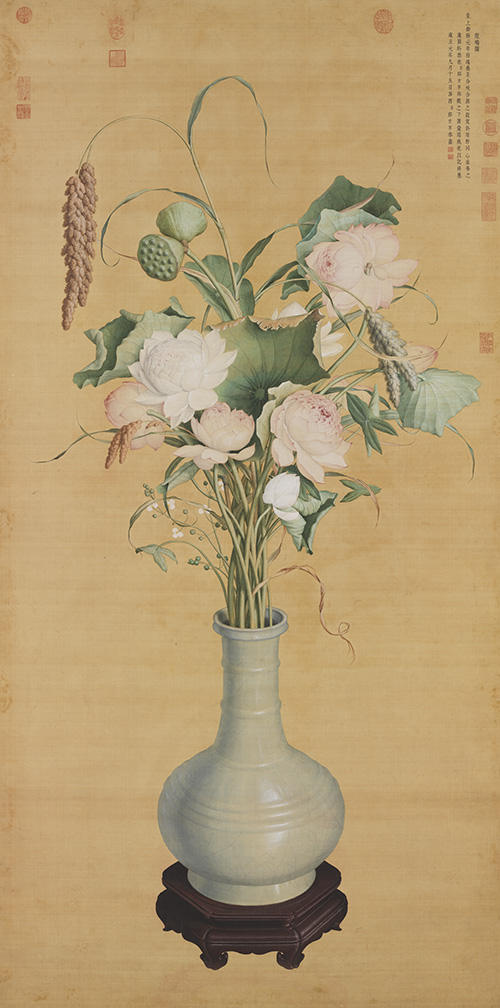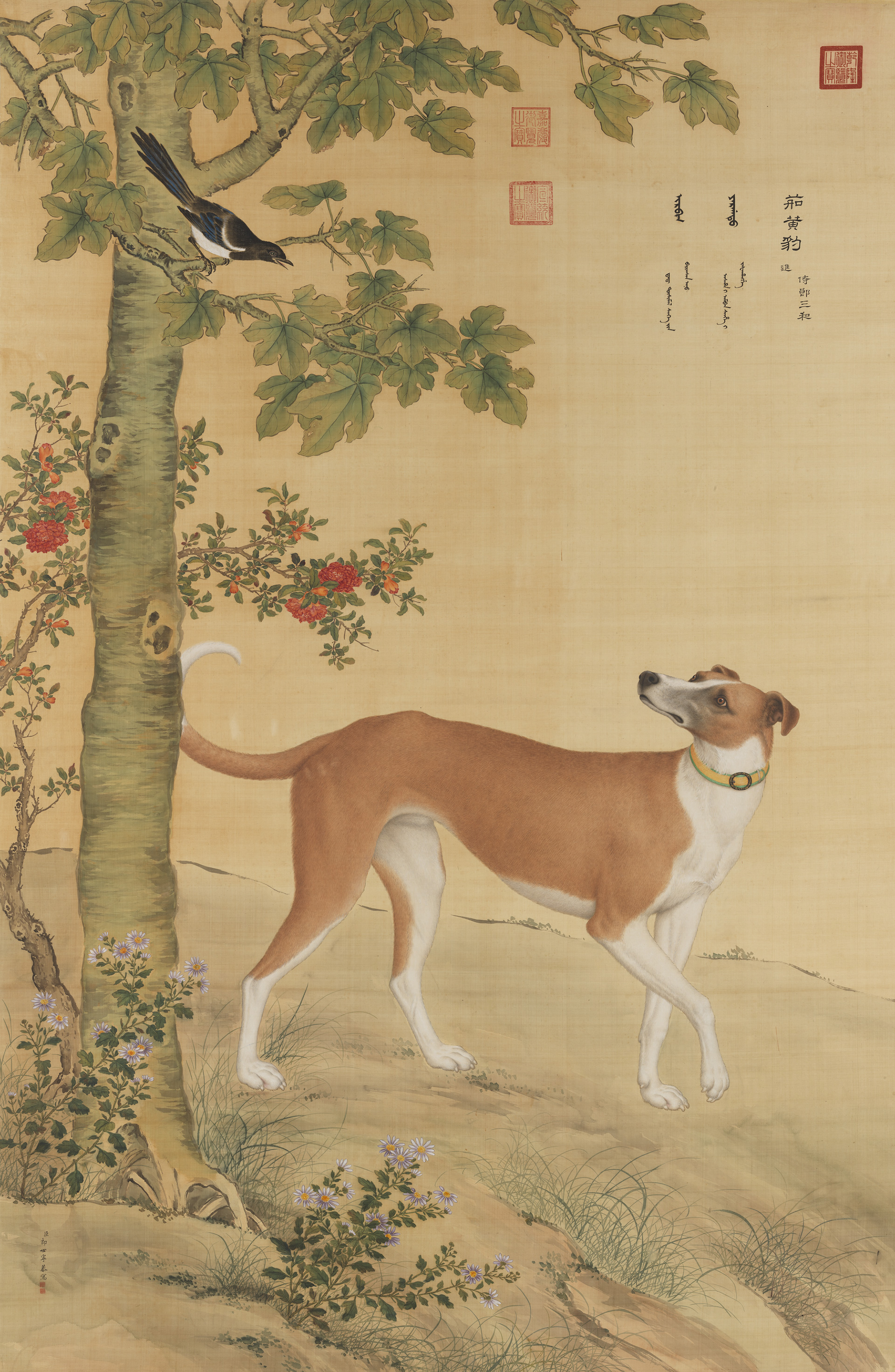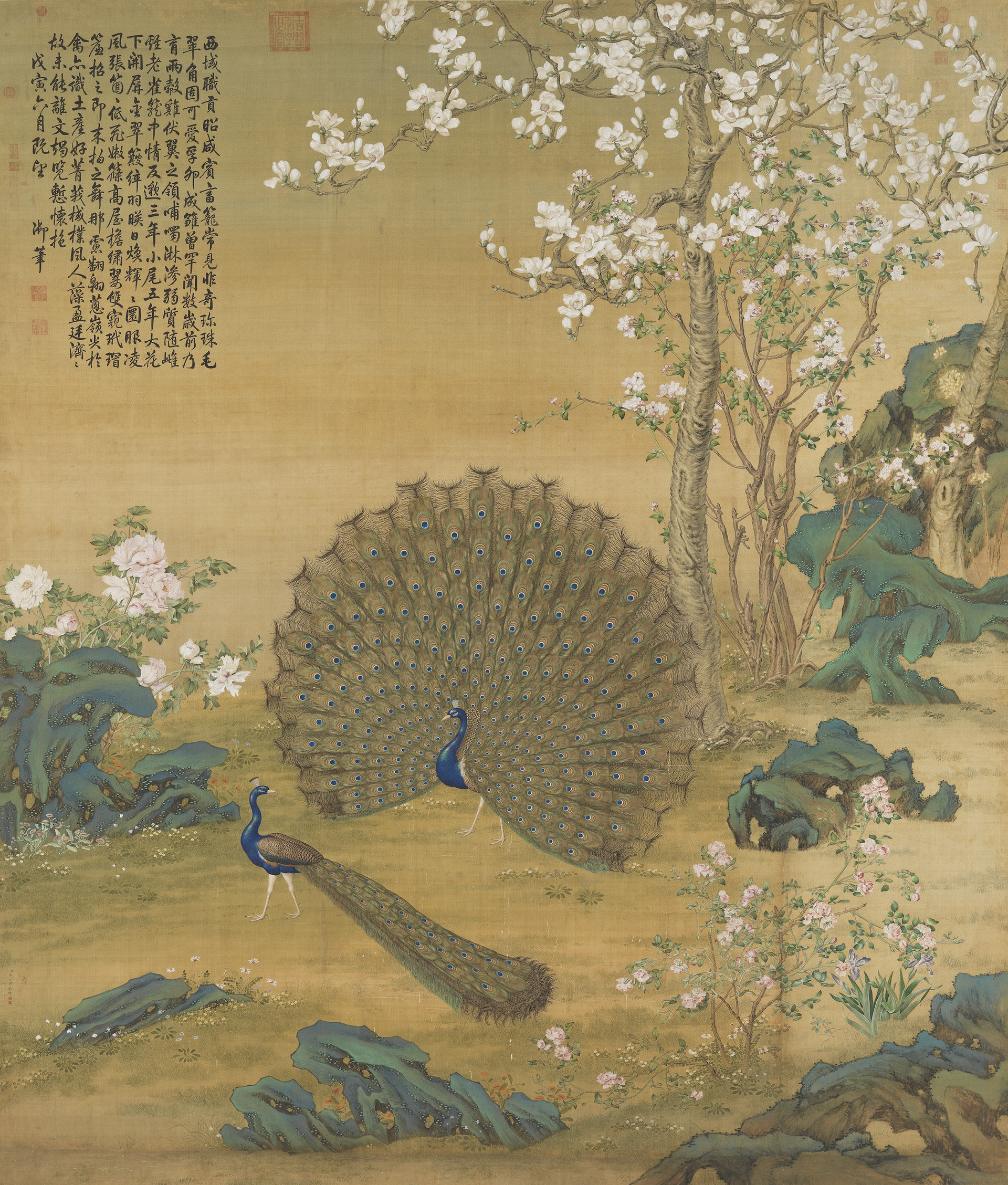Who is Giuseppe Castiglione?
Giuseppe Castiglione was born in Milan and traveled to Beijing as a Jesuit missionary in 1715. He was not the palace painter at first, but he worked in an enamel workshop. When the Yongzheng emperor took the throne he was commissioned to paint “One Hundred Horses” which is posted below. When the painting was shown to the Qianlong Emperor he was appointed to be the principal court painter (The Grandeur of the Qing: Asia for Educators). During his time in China, he adopted the name Lang Shining. Later in 1748 he was elevated to be the administrator of the imperial parks and vice-president of the six boards. Castiglione died in 1766 in Beijing leaving behind many paintings and a lasting impact on art in China (The Passion of Giuseppe Castiglione).
The Art
The painting below is the earliest of Castiglione’s painting done in the Qing court, painted in 1723. The plants that are the subject of the plant represent a sagacious rule. Western Italian art focused on realism which is exemplified in this painting. Renaissance art styles had four important techniques, sfumato, chiaroscuro, perspective, foreshortening, and proportion (Krieger Renaissance painting techniques). Sfumato is a subtle blending of colors and the blurring of sharp lines, this can be seen in the coloration of the flowers and leaves. Chiaroscuro is the strong contrast between light and dark. Note that the vase is highlighted with white pigment to make it more dynamic. Perspective, foreshortening, and proportion relate to the subject and give the illusion of depth. The subject of the painting is traditional Chinese and Castiglione used western techniques to paint it (Portrayals from a Brush Divine: A Special Exhibition on the Tricentennial of Giuseppe Castiglione’s Arrival in China_The Years Before and After Coming to China).

Hanging scroll, ink and colors on silk
Source
The next set is Castiglione’s most famous painting “One Hundred Horses” which was finished in 1728. Chinese paintings are traditionally done on silk with ink, so the artist only has one chance with the final project. The black and white drawing is a section of the first draft that was taken before the emperor for approval. Below that is the final painting that is 25ft long. The trees in the foreground are Western in style and give the painting depth additionally Castilione plays with shadows and light to make the horses pop against the background another hallmark of the Italian painting style. Additionally, the cross-hatching that is used to illustrate the vegetation in paint is Western in style. The background however is done in a more traditional Chinese style with the mountains fading out. The horses are outlined as well to provide contrast to the background, this method is called Xianfa style and is attributed to Castiglione (Portrayals from a Brush Divine: A Special Exhibition on the Tricentennial of Giuseppe Castiglione’s Arrival in China_Conceiving and Completing).

Handscroll; ink on paper
Source
Add block

Handscroll, ink and colors on silk
Source
This next painting was done around 1747. This painting was one of ten paintings that were commissioned. All ten featured a different palace dog, this being “Tawny-Yellow Leopard”. This painting is an example of the blending between Chinese and Italian art styles. There is a tree in the foreground similar to “One Hundred Horses” however there is much less shadow work at play. The dog is painted much more in the Italian style with depth in the eyes, additionally, the use of white pigments in the magpie and dog is quite western. It is also interesting to note that the dog name and who gifted them is written in Chinese, Manchu, and Mongolian in the top right corner (Portrayals from a Brush Divine: A Special Exhibition on the Tricentennial of Giuseppe Castiglione’s Arrival in China_Tributes to Realism for Imperial Review).

Hanging scroll, ink and colors on silk
Source
The final piece in my digital museum is “Peacock Spreading Its Tail Feathers”. Emperor Qianlong commissioned his piece and he specified that it should show a fusion of Eastern and Western Art styles. This is most evident when comparing the subject of the painting, the two peacocks to the background. The underside of the peacocks is in shadow giving them depth, additionally, there is the use of white pigments to highlight the neck and glossy feathers. In contrast, the background lacks much of the shadow that is exemplified in “One Hundred Horses” (Giuseppe Castiglione: Lang Shining New Media Art Exhibition_Paintings Come Alive: New Media Installations Inspired by Giuseppe Castiglione’s Works).

Hanging scroll, ink and colors on silk
Source
The Changes
Castiglione is praised for merging the art styles of the East and West, however, this change did not take place overnight. Castiglione’s first painting featured is completely Italian in art style there is nothing Chinese about the art except for the subject of the painting and the medium used. In the “One Hundred Horses” painting there is much more overlap in the syles. The last two paintings are done 20 years after the first two and Castiglione has solidified his style. The subjects are painted in a Western-style with depth and shadows, and the backgrounds are more Eastern with more flat coloration. Additionally, I find it amazing that Castiglione was able to recreate Italian art styles on the traditional Chinese media of silk and ink because there is no room for error like there is on canvas.
Sources
Asia for Educators, Columbia University. “The Grandeur of the Qing: Asia for Educators.” The Grandeur of the Qing | Asia for Educators, afe.easia.columbia.edu/qing/art-castiglione.html.
Ehret-Kump, Matthew, et al. “The Passion of Giuseppe Castiglione.” China Channel, 1 Apr. 2019, chinachannel.org/2019/01/17/castiglione/.
“Giuseppe Castiglione: Lang Shining New Media Art Exhibition_Paintings Come Alive: New Media Installations Inspired by Giuseppe Castiglione’s Works.” Giuseppe Castiglione: Lang Shining New Media Art Exhibition_, theme.npm.edu.tw/exh104/langshining/taipei/en/page-2.html#main.
Krieger, Lauren. Renaissance Painting Techniques. 8 Mar. 2018, editions.covecollective.org/chronologies/renaissance-painting-techniques#:~:text=The%20most%20important%20techniques%20that,significant%20shift%20in%20art%20history.
Metmuseum.org, www.metmuseum.org/art/collection/search/44632.
“Portrayals from a Brush Divine: A Special Exhibition on the Tricentennial of Giuseppe Castiglione’s Arrival in China_Conceiving and Completing.” Portrayals from a Brush Divine: A Special Exhibition on the Tricentennial of Giuseppe Castiglione’s Arrival in China_, theme.npm.edu.tw/exh104/giuseppecastiglione/en/page-4.html#main.
“Portrayals from a Brush Divine: A Special Exhibition on the Tricentennial of Giuseppe Castiglione’s Arrival in China_The Years Before and After Coming to China.” Portrayals from a Brush Divine: A Special Exhibition on the Tricentennial of Giuseppe Castiglione’s Arrival in China_, theme.npm.edu.tw/exh104/giuseppecastiglione/en/page-2.html.
“Portrayals from a Brush Divine: A Special Exhibition on the Tricentennial of Giuseppe Castiglione’s Arrival in China_Tributes to Realism for Imperial Review.” Portrayals from a Brush Divine: A Special Exhibition on the Tricentennial of Giuseppe Castiglione’s Arrival in China_, theme.npm.edu.tw/exh104/giuseppecastiglione/en/page-6.html#main.